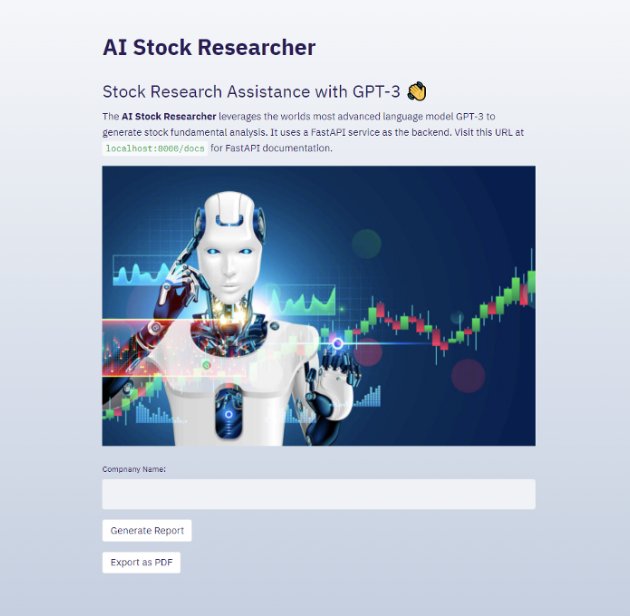20 Top Ideas For Deciding On Trading Ai Bot Websites
20 Top Ideas For Deciding On Trading Ai Bot Websites
Blog Article
Top 10 Tips To Evaluate The Ai And Machine Learning Models In Ai Trading Platforms For Stock Prediction And Analysis.
In order to get accurate information, accurate and reliable it is essential to check the AI models and machine learning (ML). Incorrectly designed models or those that oversell themselves could result in inaccurate forecasts as well as financial loss. Here are 10 top ways to evaluate the AI/ML platforms of these platforms.
1. Learn the purpose of the model and its Approach
Clarity of objective: Decide whether this model is designed for trading in the short term or long-term investment and sentiment analysis, risk management, etc.
Algorithm disclosure: Find out whether the platform has disclosed which algorithms it employs (e.g. neural networks or reinforcement learning).
Customizability. Assess whether the model's parameters can be tailored according to your own trading strategy.
2. Measuring model performance metrics
Accuracy: Check the accuracy of the model's predictions, but don't rely solely on this measure, since it could be misleading in the financial market.
Precision and recall: Evaluate how well the model identifies true positives (e.g. accurately forecasted price movements) and minimizes false positives.
Risk-adjusted results: Determine whether model predictions result in profitable trading in the face of the accounting risks (e.g. Sharpe, Sortino etc.).
3. Check the model with Backtesting
Backtesting the model by using historical data allows you to compare its performance with previous market conditions.
Tests with data that were not being used to train: To avoid overfitting, test the model with data that was never previously used.
Analysis of scenarios: Check the model's performance in different market conditions (e.g. bear markets, bull markets, high volatility).
4. Check for Overfitting
Signs of overfitting: Search for overfitted models. These are models that perform extremely well on training data and poorly on unobserved data.
Regularization: Determine if the platform is using regularization methods such as L1/L2 and dropouts to prevent excessive fitting.
Cross-validation is an essential feature for any platform to use cross-validation when assessing the model generalizability.
5. Examine Feature Engineering
Find relevant features.
Feature selection: Ensure the system selects features that are statistically significant. Also, eliminate irrelevant or redundant data.
Dynamic feature updates: Verify if the model adapts to changes in features or market conditions in the course of time.
6. Evaluate Model Explainability
Interpretation: Make sure the model provides clear explanations for the model's predictions (e.g. SHAP values, the importance of features).
Black-box models: Be wary of applications that utilize excessively complicated models (e.g. deep neural networks) with no explainability tools.
User-friendly Insights: Verify that the platform provides an actionable information in a format traders are able to easily comprehend and use.
7. Examine the Model Adaptability
Market shifts: Determine if your model can adapt to market changes (e.g. new rules, economic shifts, or black-swan events).
Continuous learning: Determine whether the platform continually updates the model to incorporate the latest data. This can boost performance.
Feedback loops. Ensure you incorporate user feedback or actual results into the model in order to improve it.
8. Examine for Bias or Fairness
Data bias: Ensure that the information provided in the training program is accurate and does not show bias (e.g. an bias towards certain sectors or time periods).
Model bias: Find out if you are able to actively detect and reduce the biases in the forecasts of the model.
Fairness: Make sure the model doesn't favor or disadvantage certain stocks, sectors or trading styles.
9. Assess the computational efficiency
Speed: Check if your model is able to make predictions in real time or with minimal delay particularly when it comes to high-frequency trading.
Scalability: Check whether the platform can manage massive datasets and many users without affecting performance.
Utilization of resources: Ensure that the model has been designed to make optimal use of computational resources (e.g. GPU/TPU use).
Review Transparency, Accountability, and Other Problems
Documentation of the model: Ensure that the platform provides detailed documentation on the model's architecture and training process.
Third-party audits : Confirm that your model has been audited and validated independently by a third party.
Check if there are mechanisms in place to detect errors and failures of models.
Bonus Tips
User reviews: Conduct user research and conduct cases studies to evaluate the performance of a model in the real world.
Free trial period: Try the accuracy of the model and its predictability with a demo, or a no-cost trial.
Support for customers: Make sure the platform provides a solid support to address problems with models or technical aspects.
These tips will help you assess the AI and machine-learning models used by platforms for stock prediction to make sure they are reliable, transparent and aligned with your goals for trading. See the best ai trading platform hints for more recommendations including copyright ai trading bot, stock market software, ai copyright trading bot, trader ai, best ai trading software, ai invest, ai trade, best ai etf, trading with ai, stock analysis tool and more.
Top 10 Tips To Assess The Regulatory Compliance Of Ai Stock Predicting/Analysing Trading Platforms
Regulatory compliance is a critical element when it comes to looking at AI stock predicting/analyzing trading platforms. Compliance is essential since it ensures that the platform is in compliance with regulations and legal frameworks. It also safeguards users' data. Here are the top ten tips for assessing regulatory compliance.
1. Verify the License and Registration
Regulatory Authorities: Make sure that the platform registered with the relevant regulatory authorities (e.g. SEC US, FCA UK and ASIC Australia) and also has an appropriate license.
Verify the broker collaboration: If your platform integrates with brokers or brokers, make sure they are licensed and regulated.
Public records: Go to the official website of the regulator to see the status of registration as well as past violations.
2. Review the privacy of your data Compliance
GDPR: If you operate in or serving users in the EU Make sure that the platform meets the requirements of the General Data Protection Regulation (GDPR).
CCPA: California Consumer Privacy Act compliance is mandatory for users.
Policies on handling data: Check the data privacy policy of the platform to find out the way it describes the collection, storage, and sharing.
3. Examine Anti-Money Laundering (AML) Measures
AML Policies: The platform should have solid AML (Anti-Money Laundering) policies to identify the money laundering process and stop it.
KYC procedures. Check the platform you use follows Know Your Customer processes for confirming user identity.
Examine the platform's monitoring of transactions. Does it monitor transactions and report any suspicious activity to relevant authorities?
4. Check for Compliance With Trading Regulations
Market manipulation: Ensure the platform has safeguards to prevent market manipulation, such as spoofing or wash trading.
Order types. Check that the platform is in compliance with all rules regarding order type (e.g. there's no illegal stop loss hunting).
Best execution: Make sure your platform is following the most efficient execution methods. This will ensure that trades are carried out at the highest possible cost.
5. Cybersecurity Assessment
Data encryption: Ensure that the platform uses encryption to secure data in transit or while at rest.
Response to incidents: Verify that the platform has an incident response plan in place to deal with cyber-attacks or data breaches.
Certifications: Make sure the platform is certified for cybersecurity.
6. Evaluate Transparency and Disclosure
Fee disclosure - Ensure that the fees are fully revealed, including additional or hidden charges.
Risk disclosure - Make sure that the platform offers clear information on risk. This is crucial for trading strategies with high leverage or risk.
Performance reporting: Check if the platform provides transparent and accurate performance reports for its AI models.
7. Check the Compliance with International Regulations
Cross-border trading If you are planning to trade internationally, make sure the platform complies with all applicable laws.
Tax reporting: Determine whether there are any reports or tools to help you comply with the tax regulations.
Security: Make sure whether the platform is in compliance with international sanctions, and doesn't allow trading with countries or entities that are banned.
8. Assess record-keeping and audit trails
Transaction records: For compliance and auditing reasons, make sure that the platform maintains complete records of all transactions.
Logs of user activity Verify that your platform tracks all activities by users, including logins, transactions, and adjustments to settings for accounts.
Audit-readiness: Determine whether the platform is capable of generating all the required documentation and logs needed for an audit by a regulatory agency.
9. Evaluation of Compliance AI Specific Regulations
Algorithmic rules for trading: If the trading platform uses algorithms, ensure that it complies with the regulations of MiFID II for Europe or Reg. SCI for the U.S.
Fairness and Bias: Ensure that the platform monitors and reduces biases in its AI models to ensure fair trading.
Explainability: Some laws require that platforms provide explanations to AI-driven predictions or choices.
10. Review User Feedback and Review Regulatory History
User feedback: Read user reviews to assess the reputation of the platform for compliance with regulations.
Check the regulatory history to determine if there have been penalties or fines for infractions of rules.
Third-party Audits: Ensure that the platform has been subjected to third-party audits to ensure that it is in compliance with all regulations.
Bonus Tips
Legal consultation: Consult with an expert in the field of law regarding the compliance of the platform with relevant rules.
Trial period: Try a free trial or demo to test the platform's compliance capabilities and the documentation.
Customer support: Ensure that the platform offers support for compliance-related questions or problems.
If you follow these guidelines, you can effectively assess the compliance with regulations of AI stock predicting/analyzing trading platforms, ensuring you choose one that adheres to legal guidelines and protects your interests. It is essential to be in compliance because it not only lowers the risk of legal liability, but also builds trust and confidence for the platform. View the best free ai tool for stock market india for site advice including copyright ai trading bot, ai chart analysis, incite, trading ai, ai hedge fund outperforms market, chart ai trading, trader ai review, ai stocks, ai trading software, getstocks ai and more.